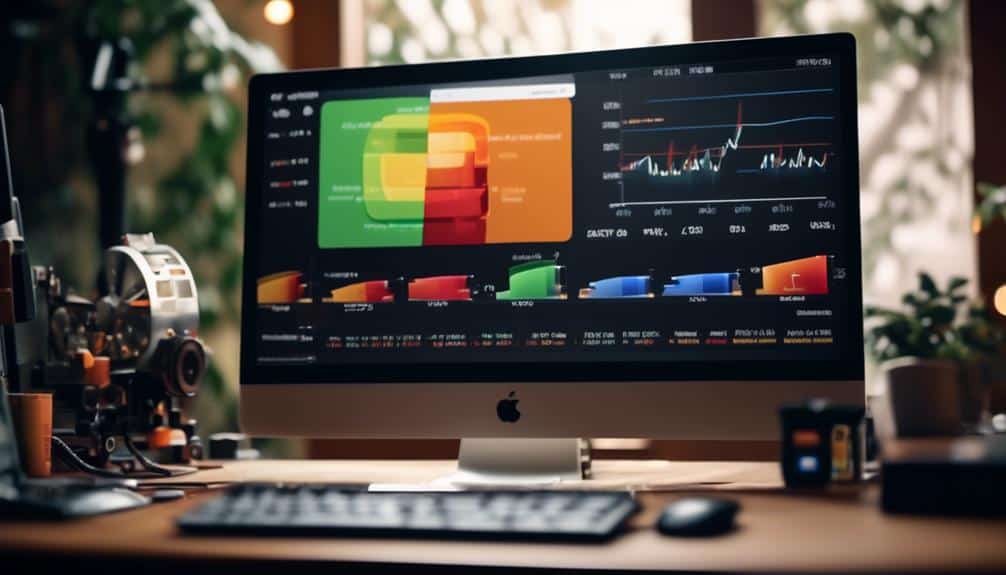Decoding Ad Success: Analyzing Performance Metrics for Google and Facebook Campaigns
Deciphering digital advertising data can be a daunting task, especially when it comes to dissecting the performance metrics of Google and Facebook campaigns.
From click-through rates to conversion tracking, the realm of online advertising is filled with intricate details that can make or break your marketing efforts.
As you navigate through the labyrinth of data points and analytics, you'll soon realize that understanding these metrics is not just about numbers; it's about uncovering hidden insights that can revolutionize the way you strategize and optimize your ad campaigns.
Key Takeaways
- Analyzing both click-through rate (CTR) and conversion rate is essential for enhancing ad campaign effectiveness.
- Tailoring ads to specific audience segments and using personalized content can significantly improve conversion rates.
- Comparative analysis of reach, engagement metrics, and conversion rates between platforms is crucial for optimizing ad spend.
- Data interpretation through visualization, trend analysis, and regular metric reviews are vital for making data-driven decisions to improve campaign performance.
Key Metrics for Google Ads

When assessing the performance of your Google Ads campaigns, key metrics serve as crucial indicators of success and areas for optimization. Two fundamental metrics to focus on are the click-through rate (CTR) and the conversion rate. The click-through rate measures the percentage of people who click on your ad after seeing it. A high CTR indicates that your ad is relevant and engaging to your target audience. Monitoring this metric allows you to refine your ad copy, keywords, and targeting to improve campaign performance.
On the other hand, the conversion rate is equally vital as it tracks the percentage of users who not only click on your ad but also complete a desired action, such as making a purchase or signing up for a newsletter. A low conversion rate could signal issues with your landing page, call-to-action, or overall offer. By analyzing and optimizing both the click-through rate and the conversion rate, you can enhance the effectiveness of your Google Ads campaigns and drive better results.
Tracking Success on Facebook
To further optimize your digital marketing strategies, shifting focus from key metrics in Google Ads to tracking success on Facebook unveils a new realm of performance evaluation and improvement opportunities.
When monitoring your Facebook campaigns, paying close attention to engagement rates is crucial. Engagement rates indicate how well your content resonates with your audience, providing valuable insights into what type of posts are most effective in driving interaction. By analyzing these rates, you can refine your content strategy to enhance user engagement and increase brand visibility.
Moreover, audience segmentation is a powerful tool for tracking success on Facebook. By dividing your target audience into specific groups based on demographics, interests, or behaviors, you can tailor your ads to be more relevant and impactful. Understanding the preferences of different audience segments enables you to create personalized content that speaks directly to their needs and desires, ultimately driving higher conversion rates and maximizing ROI.
Comparative Analysis of Metrics

Conducting a comparative analysis of key performance metrics across Google and Facebook campaigns yields valuable insights into the effectiveness of your advertising strategies. By comparing the performance data from these two platforms, you can optimize your ad spend and maximize your ROI.
Here's a breakdown of the essential aspects to consider in your metric analysis:
- Reach and Impressions: Compare the reach and impressions generated by your Google and Facebook campaigns to understand which platform is driving more visibility for your ads.
- Engagement Metrics: Analyze metrics like click-through rates, likes, shares, and comments to gauge the level of audience interaction on each platform.
- Conversion Rates: Evaluate the conversion rates from both Google and Facebook campaigns to determine which platform is more effective in converting leads into customers.
- Cost Per Acquisition (CPA): Calculate the CPA for each platform to assess the cost-effectiveness of acquiring a customer, helping you allocate your budget more efficiently.
Data Interpretation Strategies
Utilizing effective data interpretation strategies is crucial for extracting meaningful insights from the performance metrics of Google and Facebook campaigns. Data visualization plays a pivotal role in this process, enabling you to convert raw data into comprehensible graphs, charts, or dashboards. By visualizing metrics like click-through rates, conversion rates, and cost per acquisition, you can quickly identify patterns, anomalies, and areas for improvement.
Trend analysis is another essential strategy to make sense of the data. By tracking performance metrics over time, you can uncover long-term patterns, seasonal fluctuations, or the impact of specific marketing initiatives. Understanding how key metrics trend can help you make informed decisions about budget allocation, campaign optimization, and overall marketing strategy. Whether it's identifying sudden spikes in user engagement or gradual declines in ad performance, trend analysis empowers you to react proactively and strategically.
Improving Campaign Performance

Improving campaign performance requires a deep dive into key performance indicators and strategic adjustments based on data insights. To enhance the effectiveness of your Google and Facebook campaigns, consider the following strategies:
- Optimizing Targeting: Refine your audience targeting by analyzing demographics, interests, and behaviors to ensure your ads reach the most relevant audience segment.
- Implementing A/B Testing: Conduct A/B tests on ad creatives, copy, and landing pages to identify what resonates best with your audience and optimize for higher engagement and conversions.
- Monitoring Conversion Rates: Track conversion rates at different stages of the funnel to pinpoint areas for improvement and make data-driven decisions to enhance overall campaign performance.
- Continuous Performance Analysis: Regularly review key metrics such as click-through rates, conversion rates, and return on ad spend to identify trends, patterns, and opportunities for further optimization.
Frequently Asked Questions
How Does Ad Placement Impact Performance Metrics on Google and Facebook Campaigns?
When you assess the impact of ad placement on Google and Facebook campaigns, performance metrics like click-through rates, conversions, and cost per acquisition reveal crucial insights. Analyzing these metrics informs strategic decisions for optimizing campaign success.
What Are Some Common Pitfalls to Avoid When Interpreting Campaign Data From Google and Facebook?
When interpreting campaign data from Google and Facebook, avoid misinterpretation by ensuring data accuracy. Common pitfalls include overlooking attribution models, misjudging conversion tracking, and neglecting to consider the impact of ad fatigue.
How Do Different Target Audiences Affect the Effectiveness of Google and Facebook Ads?
When targeting different audiences in Google and Facebook ads, you can analyze how audience segmentation impacts ad relevance, influencing conversion rates and engagement metrics. Tailoring your message to specific groups enhances effectiveness and drives results.
Can You Provide Examples of Successful Campaigns That Utilized Unconventional Metrics to Measure Success?
When exploring unconventional strategies in ad campaigns, consider metrics innovation. Success stories like XYZ Co.'s use of sentiment analysis over click-through rates highlight the power of thinking beyond traditional metrics for campaign evaluation.
What Are Some Potential Challenges in Accurately Attributing Conversions to Specific Ad Campaigns on Google and Facebook?
Navigating challenges in accurately attributing conversions to specific ad campaigns on Google and Facebook can be daunting. Attribution models, varied ad placements, and complex conversion paths contribute to the intricacies marketers face in determining campaign efficacy.
Conclusion
In conclusion, by closely monitoring key metrics for Google Ads and Facebook campaigns, you can gain valuable insights into the performance of your advertising efforts. Comparative analysis of these metrics can help you identify areas for improvement and optimize your campaigns for better results.
By utilizing data interpretation strategies and continuously tweaking your strategies, you can enhance the success of your ad campaigns and achieve your marketing goals more effectively. Keep analyzing, adjusting, and refining to drive better performance.








